The Poetry of Revolt
 Drawing again on the excellent Jadaliyya site here are the opening paragraphs of an article speaking to the poetry — not meant metaphorically — that the Egyptian uprising is giving birth to:
Drawing again on the excellent Jadaliyya site here are the opening paragraphs of an article speaking to the poetry — not meant metaphorically — that the Egyptian uprising is giving birth to:
The Poetry of Revolt
It is truly inspiring to see the bravery of Egyptians as they rise up to end the criminal rule of Hosni Mubarak. It is especially inspiring to remember that what is happening is the culmination of years of work by activists from a spectrum of pro-democracy movements, human rights groups, labor unions, and civil society organizations. In 2004, when Kefaya began their first public demonstrations, the protesters were usually outnumbered 30 to one by Central Security Forces. Now the number has reversed—and multiplied.
No less astonishing is the poetry of this moment. I don’t mean “poetry” as a metaphor, but the actual poetry that has played a prominent role in the outset of the events. The slogans the protesters are chanting are couplets—and they are as loud as they are sharp. The diwan of this revolt began to be written as soon as Ben Ali fled Tunis, in pithy lines like “Yâ Mubârak! Yâ Mubârak! Is-Sa‘ûdiyya fi-ntizârak!,” (“Mubarak, O Mabarak, Saudi Arabia awaits!”). In the streets themselves, there are scores of other verses, ranging from the caustic “Shurtat Masr, yâ shurtat Masr, intû ba’aytû kilâb al-’asr” (“Egypt’s Police, Egypt’s Police, You’ve become nothing but Palace dogs”), to the defiant “Idrab idrab yâ Habîb, mahma tadrab mish hansîb!” (Hit us, beat us, O Habib [al-Adly, now-former Minister of the Interior], hit all you want—we’re not going to leave!). This last couplet is particularly clever, since it plays on the old Egyptian colloquial saying, “Darb al-habib zayy akl al-zabib” (The beloved’s fist is as sweet as raisins). This poetry is not an ornament to the uprising—it is its soundtrack and also composes a significant part of the action itself.
A History of Revolutions, a History of Poets
There is nothing unusual about poetry playing a galvanizing role in a revolutionary moment. And in this context, we might remind ourselves that making revolution is not something new for Egyptians—having had no less than three “official” revolutions in the modern era: the 1881 Urabi Revolution which overthrew a corrupt and comprador royalty; the 1919 Revolution, which nearly brought down British military rule; and the 1952 Revolution which inaugurated 60 years of military dictatorships under Nasser, Sadat and Mubarak. The first revolution succeeded in establishing the second parliamentary government on the African continent before it was crushed by foreign military intervention. In the aftermath of defeat, the British established a rapacious colonial rule over Egypt for more than 70 years. The second revolution was a sustained, popular uprising led by a range of pro-democracy activists from a range of civil institutions. Though savagely repressed, it did force the British to grant some concessions. The third revolution officially celebrated in Egypt stands apart from the first two in that it was a coup d’etat that went out of its way to circumscribe popular participation. In any case, it was accepted in the moment since it finally ended the rule of the royal family first overthrown in 1881 and initiated a process of British withdrawal from Egypt.
(continued here)

 “Interglacial Narrows (Poems 1915-2021)” Contra Mundum Press
“Interglacial Narrows (Poems 1915-2021)” Contra Mundum Press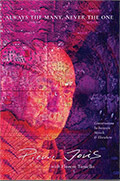 “Always the Many, Never the One: Conversations In-between, with Florent Toniello” Contra Mundum Press
“Always the Many, Never the One: Conversations In-between, with Florent Toniello” Contra Mundum Press “Conversations in the Pyrenees”
“Conversations in the Pyrenees”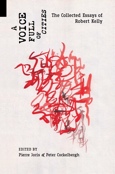 “A Voice Full of Cities: The Collected Essays of Robert Kelly.” Edited by Pierre Joris & Peter Cockelbergh
“A Voice Full of Cities: The Collected Essays of Robert Kelly.” Edited by Pierre Joris & Peter Cockelbergh “An American Suite” (Poems) —Inpatient Press
“An American Suite” (Poems) —Inpatient Press “Arabia (not so) Deserta” : Essays on Maghrebi & Mashreqi Writing & Culture
“Arabia (not so) Deserta” : Essays on Maghrebi & Mashreqi Writing & Culture “Barzakh” (Poems 2000-2012)
“Barzakh” (Poems 2000-2012) “Fox-trails, -tales & -trots”
“Fox-trails, -tales & -trots”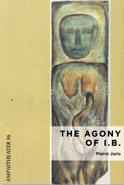 “The Agony of I.B.” — A play. Editions PHI & TNL 2016
“The Agony of I.B.” — A play. Editions PHI & TNL 2016 “The Book of U / Le livre des cormorans”
“The Book of U / Le livre des cormorans” “Memory Rose Into Threshold Speech: The Collected Earlier Poetry of Paul Celan”
“Memory Rose Into Threshold Speech: The Collected Earlier Poetry of Paul Celan”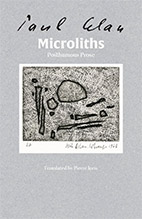 “Paul Celan, Microliths They Are, Little Stones”
“Paul Celan, Microliths They Are, Little Stones”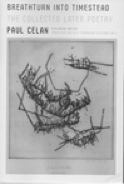 “Paul Celan: Breathturn into Timestead-The Collected Later Poetry.” Translated & with commentary by Pierre Joris. Farrar, Straus & Giroux
“Paul Celan: Breathturn into Timestead-The Collected Later Poetry.” Translated & with commentary by Pierre Joris. Farrar, Straus & Giroux